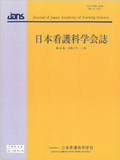Japanese
English
- 販売していません
- Abstract 文献概要
- 参考文献 Reference
要旨
目的:デジタル聴診器を用いた遠隔授業方式による聴診プログラムを作成し,それを授業に取り入れて実践し,学生からの評価に基づき有用性を検討する.
方法:A大学の2年次生85名を対象に,作成した聴診プログラムを授業に組み込んで実践し,Web調査により評価した.
結果:回答率は76.5%であった.正常な呼吸音では,聴診器の当て方による違い,呼気と吸気の違いについて「よくわかった」と回答した学生が全体の約50%を占め,異常音との区別については全体の約60%あるいはそれ以上を占めていた.心音では,全ての項目で全体の25%未満であった.リアルタイムに音を共有することで,学生間のディスカッションがしやすい方法だと「とても感じた」と回答した学生が全体の約50%を占めていた.
考察:デジタル聴診器の活用により学生間でのディスカッションがしやすく,聴診音に関する知識の理解がさらに深まるなどの有用性が示唆された.
Objective: The purpose of this study was to create a distance learning auscultation program using digital stethoscopes, incorporate the program into class, and examine its usefulness through student evaluations.
Methods: The distance learning auscultation program was incorporated into classes for 85 sophomore-year students from the nursing department of University A, and the program results were evaluated after completion through a student web survey.
Results: The response rate was 76.5%. Regarding normal breathing sounds, approximately 50% of students answered that they "understood well" differences in sound depending on how the stethoscope was applied and the difference between exhalation and inspiration. Approximately 60% or more of the students answered that they "understood well" the distinction between normal sounds and abnormal sounds. For heart sounds, less than 25% of students answered that they "understood well" all the items. Approximately 50% of the students responded that they "felt very much" that sharing sound in real time was an easy way to facilitate student discussion.
Conclusion: The results suggest that the use of digital stethoscopes facilitates discussion among students and further deepens their knowledge and understanding of auscultation sounds.
Copyright © 2024, Japan Academy of Nursing Science. All rights reserved.


